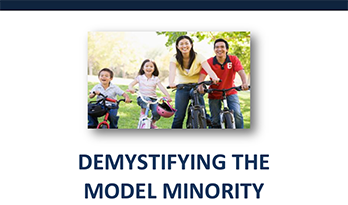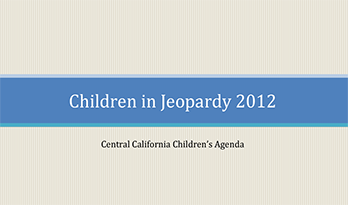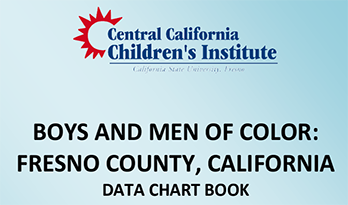Central Valley Health Policy Institute
Central California Health Policy Institute Publications
Please select from the following publications below to learn more about CVHPI's contributions to the various programs in the San Joaquin Valley.
Publication Highlights
-

From Data to Action: Addressing Social Determinants of Health in the San Joaquin Valley
October 2025This analysis draws upon the Social Determinants of Health and Health Outcomes in the San Joaquin Valley dashboard by CVHPI. The purpose of this analysis is to interpret and contextualize selected data presented in the dashboard, identifying critical patterns and interrelationships that inform evidence-based policy recommendations. This report seeks to tell the story behind the data, one shaped by geographic, economic, and systemic challenges.
-

FMCoC Lessons Learned Report
January 2025The FMCoC teamed up with CVHPI to tackle homelessness using an updated tool, CESMAT, which addresses the shortcomings of the previous VI-SPDAT tool. The homeless populations in Fresno and Madera face numerous challenges. CESMAT was designed to offer an equitable, effective way to prioritize assistance services. This report highlights the implementation process and lessons learned while integrating CESMAT.
-

State Investments in Climate Change
January 2025California faces climate risks from rising temperatures and extreme weather, threatening health and infrastructure. Vulnerable populations, particularly communities of color, are most affected. Environmental justice policies like SB 1000 and local organizations can help reduce disparities and build resilience. This report highlights funding opportunities for CBOs to address climate concerns.
-

CASE STUDY: COVID-19 Support of Fresno County Asian Americans via Racially Concordant Community Health Workers
December 2024Racial concordance between community health workers (CHWs) and Asian American/Pacific Islander (AAPI) patients improved care in Fresno County. CHWs helped AAPI communities navigate COVID-19 information, boosting participation in testing and vaccinations. This paper outlines the work of AAPI CHWs within the Immigrant Refugee Coalition (IRC), part of the COVID-19 Equity Project (CEP) in Fresno County’s pandemic response.
-

Federal Investments in Climate Change
November, 12, 2024In the United States, climate change has resulted in drastic weather conditions that disproportionately affect vulnerable populations, such as non-Hispanic Black residents and farmworkers. . Given these challenges, funding has been allocated toward environmental justice (EJ) strategies to protect vulnerable populations. As experts in community outreach and advocacy, local CBOs can play a large role in promoting and achieving these EJ goals. The objective of this report is to highlight funding opportunities that local CBOs can engage with in addressing local climate concerns.
-

East and Southeast Asian Americans in Merced
October 25, 2024Merced has been home to many Asian communities that have shaped the city of Merced. Despite their contributions, Asian communities faced racial discrimination, segregation, and other challenges. The historical prejudice created current institutional inequities. The report highlights solutions for Southeast Asians to address disparities and increase opportunities and access in Merced that are ongoing.
Sort Publications by Year

Racial Equity Analysis of VI-SPDAT Data
October 17, 2024
The VI-SPDAT assessment has been found to create racial inequities within housing prioritization assignments for unhoused communities. The Housing Equity project aimed to create a new equitable assessment that addresses earlier disparities, in part through conducting a racial equity analysis to examine racial trends present in housing prioritization assignments and BIPOC question response likelihood. Using Singles Participant data, the analysis revealed VI-SPDAT question phrasing may contribute to BIPOC’s deprioritization and equitable amendments are needed.

Climate Grant Dashboard: Overview
August 7, 2024
Increasingly dangerous climate change weather events such as heat waves and drought have significant implications for San Joaquin Valley communities, including reduced economic opportunity and reduced access to high quality food. The Central Valley Health Policy Institute’s Grant Dashboard will inform community-based organizations (CBOs) about grant funding that is or may become available to support climate efforts throughout the Central Valley for future generations to enjoy.

BUILDING HEALTHY COMMUNITIES IN THE SAN JOAQUIN VALLEY: DATA REPORT UPDATE
June 26, 2024
This report is an update to the “Building Healthy Communities in the San Joaquin Valley: Preliminary Baseline Data Report” written in 2010. This updated report expands on the original “Big Four Results” outlined in 2010 to add data on how “North Star Goals,” a later framework of the BHC work, changed the San Joaquin Valley. Findings reveal that the San Joaquin Valley made both health and policy improvements that have made communities healthier.

Food Deserts and Hypertension Prevalence in the Central Valley
May 28, 2024
This study aimed to understand the geospatial association between food deserts, transportation, and hypertension prevalence in California at the census tract level. Findings revealed that communities in food deserts without adequate transportation were at a significantly higher risk of hypertension, highlighting the importance of addressing both food access and transportation infrastructure to mitigate hypertension prevalence.

Lost Time, Lost Lives: Racial/Ethnic Disparities in Years of Life Lost to Breast Cancer
in California
April 23, 2024
This brief presents disparities in years of life lost (YLL) from breast cancer among California females 2016-2018 by race/ethnicity. It highlights that African American and Asian women had higher age-standardized YLL rates than White women, underscoring the need for equitable access to healthcare and targeted interventions to improve outcomes for underserved racial/ethnic groups.

Polluted Air, Clouded Health: Investigating Air Pollution and Breast Cancer Mortality
in California
January 25, 2024
This brief examines the potential geographic association between air pollution and
breast cancer mortality rates by women aged 45-64 and 65-85+ in California at the
zip code level. The brief hopes to inform policymakers, healthcare professionals,
and the community on the
geographical disparities present in breast cancer mortality and risk factors that
can be targeted to produce policy changes.

Advancing Health Literacy
December 21, 2023
To address disparities in testing, vaccine uptake, COVID-19 cases, and chronic disease management within Fresno and surrounding regions, the Advancing Health Literacy (AHL) program was developed. Focus groups and interviews with AHL CHW's highlighted key findings about their workload experiences, systemic barriers facing Fresno residents and reinforce that in order to achieve equity in Fresno, it would be done via policy change, investment in infrastructure, and sustainable CHW interventions.
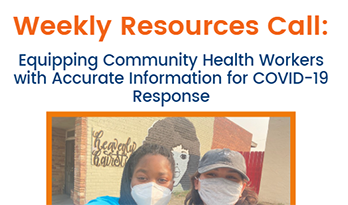
Weekly Resources Call
December 21, 2023
The Spanish Weekly Resources Call was integrated into the COVID-19 Equity Project’s Immigrant Refugee Coalition community health worker (CHW) model to supplement health information and strengthen the capacity of the CHWs to serve vulnerable communities in Fresno County. The community resources call was an integral part of the pandemic response and was a tool to help CHWs keep updated with ever-changing guidelines and emerging science.

Mil Hojas (A Thousand Layers): Leadership and Power Building for Park Equity
November 30, 2023
Through resident and youth outreach, the Fresno BHC Coalition helped to lead Fresno’s park equity efforts through the #Parks4All campaign and securing the realization and implementation of Measure P, a tax measure to fund Fresno parks. This presentation highlights how residents emerged as leaders in ushering in a historic change to how the City prioritizes park and greenspace equity in Fresno.

Meeting the Moment: How CBOs Led the COVID-19 Response in Fresno County
November 16, 2023
This case study focuses on three health equity leaders who have been involved with Fresno Building Healthy Communities (Fresno BHC) Coalition in Fresno county and who helped develop the Immigrant and Refugee Coalition’s (IRC) COVID-19 Equity Project (CEP) and the efforts of their coalition in developing and obtaining funding and support for an equity-based community health worker (CHW) model.

Cultivating Connections: Leadership and Power Building for Merced School Equity
November 9, 2023
Over the past decade, Building Healthy Communities (BHC) Merced efforts included providing a platform for residents and youth to make a difference in local schools. This case study focuses on the school advocacy and community organizing work that increased equity in Merced schools for students and parents through the development of people power and power building.

The Right to Fair and Healthy Housing: How CBOs are Leading the Fight for Housing
Security in Fresno
November 2, 2023
Through power building in Fresno around affordable housing and housing-related policies, Fresno BHC has amplified adult and youth residents’ voices, working to increase community inclusion in decision-making at public and private levels.

Invest in Southwest
September 4, 2021
To build long-lasting change, resident and advocate-driven work needed to address Fresno’s legacy of discriminatory neighborhood, housing, land use, and planning policies. Through vibrant community engagement, community organizing, advocacy, litigation, and large-scale voter education, the Fresno BHC Coalition emerged as a key player that helped the community to design southwest Fresno’s future.

What the FAX
September 2021
Fresno BHC and partner organizations started the “What the FAX” campaign to address public transit issues for youth, securing investments in local transportation. Together, youth and adult allies collected data and organized communities to collectively push for improved public transportation infrastructure throughout the city of Fresno.
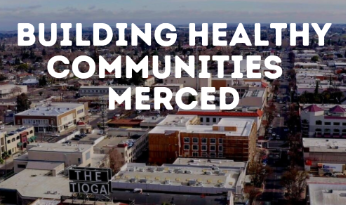
Building Healthy Neighborhoods: Merced Report
August 2021
Building Healthy Communities (BHC) was part of a ten-year, place-based initiative to advance health equity at the local level beginning in 2010. This fourteen-site initiative, funded by The California Endowment, focused on advocacy work and capacity building for change in each geographic community. The role of BHC Merced was to convene local residents, leaders, organizations in The Merced Place and provide a platform to elevate their voices.

Fresno COVID-19 Equity Project: White Paper
July 7, 2021
Central Valley Health Policy Institute will present the findings, structure, and model of the COVID-19 Equity's Project White Paper Presentation. In addition, CVHPI will present how the collaborative efforts and CBO's adaptive leadership contributed to mitigating the spread of COVID-19 in our most vulnerable communities.

Sweet Potato Project Final Report
March 2021
The Sweet Potato Project is a pilot program implemented at the West Fresno Family Resource Center to address mental health disparities among African American youth aged 12-15 in West Fresno. It aims to develop self-esteem, leadership, agribusiness, and entrepreneurial skills while addressing social and environmental stressors. The program is part of the California Reducing Disparities Project, funded by the Mental Health Services Act. CVHPI evaluated the program from 2018-2021 using a mixed methods approach.
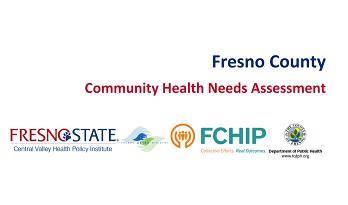
Fresno County Community Health Needs Assesment Report 2020
Fresno County Community Health Needs Appendices 2020
2020
This community health needs assessment was designed to reach underserved and vulnerable populations, understand their needs, develop priority areas of focus for the region, and establish the foundation for a sustainable Community Health Improvement Plan (CHIP) in Fresno County.
.
Dentistry During and After the COVID-19 Pandemic: A Dental Providers’ Perspective
2020
As many dental providers and their staff prepare to re-open their practices, it is essential to understand their perspective on how the COVID-19 pandemic may have a long term impact on their practices and dentistry in general. This report presents findings of a survey that the Central Valley Health Policy Institute sent to dental providers nationwide. As a timely response to the pandemic, this work aims to understand the dental providers’ perspective on how dentistry is and will be impacted by the COVID-19 pandemic and to know their suggested policy recommendations to support the dental community.
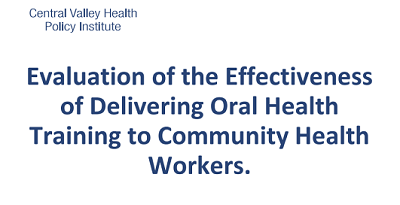
Evaluation of the Effectiveness of Delivering Oral Health Training to Community Health Workers
2020
To address low oral health literacy level, CVHPI prepared an oral health training suitable for Community Health Workers (CHWs) and Promotores. The training aimed to empower the CHWs with the knowledge needed about oral health and its related connection to general health across the life span. The main goal was to improve their oral health literacy and subsequently the communities they serve.

Oral Health Barriers for California's San Joaquin Valley Underserved and Vulnerable
Populations
October 2017
Oral health is recognized as an essential part of an individual’s overall health. The aim of this project is to understand how California’s San Joaquin Valley residents think about, feel about, and experience oral health services. This report presents findings from 659 surveys measuring healthy and unhealthy oral health knowledge, oral health needs and barriers. Surveys were collected at clinic and non-clinic sites throughout the San Joaquin Valley, an area characterized by its large Latino and immigrant populations, as well as its low levels of education and high levels of poverty. The results indicate disparities by ethnicity and language, insurance coverage, and education.

Community Benefits Needs Assessment in South Fresno
August 2017
In this report, the Central Valley Health Policy Institute at Fresno State share the findings of focused group interviews with residents of south Fresno neighborhoods. Based on these data, the report describes a number of potentially cost-effective, patient-centered and culturally responsive community benefit investments to further the health of Fresno residents.
Community Benefits Needs Assessment in South Fresno Report (PDF)
Executive Summary in English (PDF)
Executive Summary in Spanish (PDF)

San Joaquin Valley Public Health Consortium: Report Series
2017

African American Infant Mortality in Fresno County
January 2016
Much higher rates of infant mortality and other adverse birth outcomes have been noted for African Americans compared to whites nationwide and locally, even as overall rates of infant mortality have declined for many years. In response to a persistent increase in infant mortality among African Americans over the last few years, First 5 Fresno County and Fresno State’s Central Valley Health Policy Institute (CVHPI) conducted a mixed method assessment, between January 2015 and July 2015.
African American Infant Mortality in Fresno County (PDF)
African American Infant Mortality in Fresno County: Executive Summary (PDF)

Operational and Statutory Capacity of Local Health Departments in the San Joaquin
Valley
October 28, 2013
Despite having some of the state’s highest levels of poverty and poor health outcomes, the San Joaquin Valley receives less public health funding from state and federal sources than other California counties with similar populations according to a new report from the San Joaquin Valley Public Health Consortium.
This report is the first to compare the operational capacity of local health departments in eight Valley counties to their peers in California.

Place Matters for Health in the San Joaquin Valley: Ensuring Opportunities for Good
Health for All
2012
Place matters for health, and it may be more important than access to health care and health-related behaviors. The Central Valley Health Policy Institute at Fresno State and Joint Center for Political and Economic Studies released a report Wednesday, Feb. 29, comprehensively analyzing links between social, economic and environmental conditions and health in the region. The study examines the relationships between place, race and ethnicity, and health in the San Joaquin Valley of California and attempts to address two specific questions raised by the San Joaquin Valley Place Matters researchers:
- What is the relationship between social factors and premature mortality?
- What is the relationship between social factors and exposure to environmental hazards?
The report demonstrates that neighborhood conditions and the quality of public schools, housing conditions, access to medical care and healthy foods, levels of violence, availability of exercise options, exposure to environmental degradation can powerfully predict who is healthy, who is sick, and who lives longer. And because of patterns of residential segregation, these differences are the fundamental causes of health inequities among different racial, ethnic and socioeconomic groups. This study examined the relationship between social conditions, environmental factors, and health outcomes in the context of the unique demographic characteristics of the area.
Download full report
Executive Summary in English
Executive Summary in Spanish

A 2010 Profile of Health Status in the San Joaquin Valley culminates a decade of biannual reports which document the severity of the Valley’s health crises. Following national objectives, established in 2000 by the U.S. Department of Health and Human Services, the report tracks health indicator progress in eight valley counties. Findings show that over the last 10 years, there was little to no improvement on key indicators. The reports also demonstrate the range of successful policies and programs that have been piloted around the region during this time. For the most part, however, these initiatives have been tested on a small scale, in isolated communities, and without the broad public engagement needed for coordinated county-wide or regional impact. The report recommends that Fresno and the region adopt a new strategy focused on primary prevention and improving quality of life in under-resourced urban and rural communities.

Understanding Traditional Hmong Health and Prenatal Care Beliefs, Practices, Utilization
and Needs
2011
The purpose of this project is to understand the health and prenatal care beliefs, practices, and needs of Hmong women age 18-35 and men age 18-45 in Central California where the largest share of the Hmongs have settled.
Although the displacement of people from their home countries is of growing concern, little attention has been paid to the health care experiences, utilization or outcomes of refugees in the U.S. health care literature. Experiences of refugees are more complex and difficult than those of voluntary immigrants because refugees often experienced trauma in their own country, as well as being forced to leave. Voluntary immigrants most often choose to immigrate willingly in search of a better life. Trauma may further complicate acculturation for refugees and their children as they learn practical skills for survival and construct an identity in the host country (Yakushko, Watson, & Thompson, 2008).

The findings of a recent CVHPI study for the San Joaquin Valley Air Pollution Control District provide important new regional evidence for the public health consequences of air pollution. This study offers the first local evidence of short-term population-level health effects associated with elevations in PM2.5 and ozone for the San Joaquin Valley, demonstrating linear increases in rates of asthma ER and hospital admissions with increasing levels of air pollution, with effects more pronounced for children.

Hospital Council of Northern and Central California
2011
The Patient Protection and Affordable Care Act (PPACA) imposed new requirements on non-profit hospitals. Hospitals must comply with requirements regarding community health needs assessments, financial assistance policies, charges, billing and collections. The nonprofit hospital provisions of PPACA do not exempt any hospitals from its requirements. Thus, hospitals currently exempt from community benefit reporting pursuant to State law (SB 697) must now develop a community health needs assessment and report community benefits. This includes small and rural, children's charitable, public and other hospitals.
This project is the culmination of several years of collaboration between the Hospital Council of Northern and Central California (Community Benefits Managers from six hospitals--Adventist Health-Central Valley Network, Community Medical Centers, Children's Hospital Central California, Kaiser Permanente, Madera Community Hospital, Saint Agnes Medical Center) and the Central Valley Health Policy Institute (CVHPI) at California State University.
This report provides a health "snapshot" of four-county (Fresno, Madera, Kings, and Tulare) using secondary quantitative data and explores needs, strengths, challenges, and identifies priorities for action using primary qualitative data collected in 2 010-2011 . In collaboration with the Hospital Council, we identified a set of community health indicators, drawing on the Healthy People 2010 and other national and state-level projects. The indicators focus on determinants of health (economic conditions, health care access, and health behaviors), prevalence of chronic conditions, and health outcomes (morbidityÑas measured by hospital use, and mortality) and were examined from both quantitative and qualitative perspectives.

The Affordable Care Act and California's San Joaquin Valley: A CAUSE Perspective
October 2010
Steve Chooljian, M.D., John A. Capitman, Ph.D.,
Mohammad Rahman, Ph.D. , Kudzai Nyandoro, B.S.

BUILDING HEALTHY COMMUNITIES IN THE SAN JOAQUIN VALLEY: PRELIMINARY BASELINE DATA
REPORT
March 2010
This report is intended to support the ongoing planning efforts of The California Endowment Building Healthy Communities (BHC) sites in the San Joaquin Valley by beginning a regional conversation about currently available data and additional data needed to support planning and implementation of the BHC strategic initiatives.

Telemedicine in the San Joaquin Valley: Opportunities and Barriers in Adoption
December 2009
Expansion of telemedicine in the San Joaquin Valley has been slower compared to California's coastal areas. This study explored possible barriers in the adoption of telemedicine in this region by conducting several in-depth interviews of healthcare managers and practitioners. Several factors were identified as major barriers to adoption of telemedicine. It was found that factors such as, uncertainty about the benefits of telemedicine, unclear profit prospects and lack of clarity in existing 'practice' and 'labor' regulations act as major disincentives to health care providers in adoption decisions. Another notable barrier tied to the region that dissipates telemedicine adoption is the unique contractual arrangement that exists between part-time specialist physicians and the management at some healthcare facilities. Along with the provision of financial assistance, the healthcare providers in this region need to be educated on telemedicine practice guidelines. Special emphasis needs to be put on developing telemedicine business models that cater to regional socio-economic and cultural realities.

Community Needs Assessment: Arvin, Lamont, and Weedpatch, CA
September 2009
The purpose of this community needs assessment was to identify the health and psychosocial service and access needs of residents who live in Arvin, Lamont, and Weedpatch, California. These three rural communit

Place Matters: Understanding Rural/Urban Differences in Motor Vehicles Fatalities in California's
San Joaquin Valley
July 2009
Motor vehicle accidents (MVAs) remain a leading cause of injury and death in Central California's San Joaquin Valley, especially for minority, low-income citizens of rural communities. Living in a rural location may contribute to one's risk of being in an MVA. A strong majority (65%) of fatal accidents in the six counties from 2001 to 2005 occurred on rural roads. Public health experts from six counties collaborated to identify the underlying social and environmental determinants behind the disparities in rural/urban MVAs. This collaboration was part of the Place Matters national demonstration program, a national initiative of the Joint Center for Political and Economic Studies, Health Policy Institute to reduce/eliminate health disparities by targeting upstream causes associated with social determinants of health.

Human Investment Initiative: Mental Health Cluster
First year's Observations, Conclusions and Recommendations
May 1, 2009
As demonstrated by the success of the Regional Jobs Initiative, our community is in the midst of a fundamental transformation. We are shifting from the expectation that government and single interest advocacy is the answer to our problems to a recognition that solutions will require new approaches, new partnerships and every individual stepping up to take responsibility for the success and well being of all residents. We, not government, are responsible for creating the world we want. In that spirit, the Human Investment Initiative ("HII") was launched in 2007 to address the destructive force of poverty in our neighborhoods and the lack of alignment of our community resources behind shared strategies. One HII task force of private citizens, the Mental Health Cluster ("MHC"), was formed in February 2008 to evaluate mental health services in Central California. At the outset of the effort, the members of the Mental Health Cluster agreed to act in accordance with the Community Values included at the end of this report. These will be important as we take the next steps.

Oral Health Survey of Federally Qualified Health Centers in the Central Valley
March 2009
Low-income residents of the Central Valley face limited access to oral health care due to barriers, including a shortage of dental health professionals, a maldistribution of services, and a lack of providers willing to accept uninsured or publicly insured patients. Federally Qualified Health Centers (FQHCs) ease access barriers by providing oral care to underserved populations. In an effort to respond to regional concerns regarding the shortage of oral health professionals, a survey was conducted to evaluate the impact of these shortages in the Central Valley.

Environmental Health Evaluation of Rule 4901: Domestic Wood Burning
March 25, 2009
This report provides an evaluation of the regulatory and public health effectiveness of Rule 4901 as adopted by the San Joaquin Valley Air Pollution Control District on November 1, 2003. Rule 4901 set in place a 150 AQI-triggered ban on wood burning in areas of the San Joaquin Valley that have natural gas service and are below 3,000 ft elevation.

Promotoras de salud, also referred to as lay health advisors or Community Health Workers (CHWs), have been used to target hard-to reach populations, traditionally excluded racial/ethnic groups, and other medically underserved communities. Promotoras serve as the cultural bridge between community-based organizations, health care agencies, and their respective communities. Our innovative effort uses CHWs as promoters of health care access. Promotoras focus on increasing enrollment in health insurance programs, receipt of preventive care services, establishing a usual source of care and improve self-efficacy.

Promotoras: Lessons Learned on Improving Healthcare Access to Latinos
2009
Executive Summary of "The Effectiveness of a Promotora Health Education Model for Improving Latino Health Care Access in California's Central Valley"

California Program on Access to Care
Undocumented Latinos in the San Joaquin Valley: Health Care Access and Impact on Safety
Net Providers
August 2008
California has the largest number of undocumented immigrants nationwide. Out of the estimated 11.6 million undocumented immigrants living in the U.S., about one-quarter--2.7 million undocumented immigrants-- live in California. Furthermore, approximately 280,745 of these immigrants live in the San Joaquin Valley, which is the center of California's fertile agricultural region. This study explores how San Joaquin Valley safety net providers are impacted by serving undocumented Latinos and how immigrant populations, specifically Latinos and to a lesser extent Hmongs, are experiencing care access.
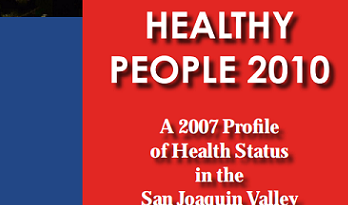
Healthy People 2010: A 2007 Profile of Health Status in the San Joaquin Valley
May 27, 2008
Researchers from the Central Valley Health Policy Institute at California State University, Fresno released a report today that reveals the Valley is not making progress toward meeting the Healthy People 2010 objectives and is likely to not reach a majority of the target measures by the end of this decade.

Assessing Mental Health Disparities Among Latinos in the San Joaquin Valley
2008
In 2000, at least 7.9 percent or 103,785 Latinos of all ages living in the eight counties
of the San Joaquin Valley (Fresno, Kern, Kings, Madera, Merced, San Joaquin, Stanislaus,
and Tulare) experienced either serious emotional disturbance (SED) or serious mental
illness (SMI). Because of limitations on mental health services and delivery system
capacities, it is often hypothesized that a sizable proportion of the population in
need of these services are not receiving them.
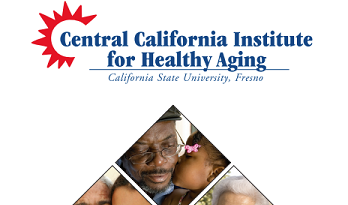
Aging in the San Joaquin Valley: Present Realities and Future Prospects
2008
This report presents an overview of the demographic,
economic, health and social characteristics of the San
Joaquin Valley's aging population. This report is a first
step in describing the issues and concerns of the older
population. In order to meet current needs and future
demands, it is imperative that we understand the aging
population and lay the framework for developing policies
and programs to meet their needs.

The Long Road to Clean Air in the San Joaquin Valley: facing the Challenge of PublicEngagement
December 2007
A report released by the Central Valley Health Policy Institute at California State University, Fresno documents the need for San Joaquin Valley residents to understand and be involved in the region's air quality policy landscape.
“The Long Road to Clean Air in the San Joaquin Valley: Facing the Challenge of Public Engagement” provides policymakers and residents with practical recommendations to enhance the public's engagement around air quality policy issues.
Read the full Air Quality Report (PDF)

Health Reform 2007: Impact on the Valley
June 2007
The San Joaquin Valley now has a unique opportunity to influence health policy and health care reform by giving a voice to the health disparities experienced by its residents and influencing the negotiations that are ongoing as the health reform debate heats up.

The San Joaquin Valley faces important challenges in pre-natal care and birth outcomes. This monograph reports on the findings of three new studies addressing aspects of this challenge: A study of three-years of California birth records, 2002-2004, 2) a qualitative evaluation of system barriers in three of the region's counties and 3) a meta-analysis and systematic review of race and insurance-related disparities in prenatal care in California compared to other states, in the context of the 1990s Medicaid expansion. The three-year analysis of California birth records explored how demographic characteristics, insurance, and residential location influence adequacy of care and birth outcomes in the San Joaquin Valley. The qualitative study, conducted in three of the region’s counties, focused on provider experiences in serving pregnant and post-partum women. The systematic review and metaanalysis of published studies on the adequacy of prenatal care focuses on how the Medicaid expansions of the 1990’s influenced racial/ethnic prenatal care disparities in California compared to other states. In this summary we provide a brief report of key findings, conclusions and policy/program recommendation. A brief background section describes findings from other studies on adequacy of prenatal care.
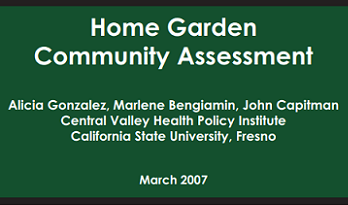
Home Garden Community Assessment
March 2007
This community assessment identifi es the healthcare, social service needs, and access
issues experienced by
members of this underserved, rural community in California’s Central Valley. In order
to provide a context for
this assessment, we begin with an overview of the community. Home Garden is a small
community of a little
over 1,700 residents. In the last decade this community has seen a shift in demographics
from a predominantly
African American to a mostly Latino population, with very limited or no access to
health and social service
facilities.
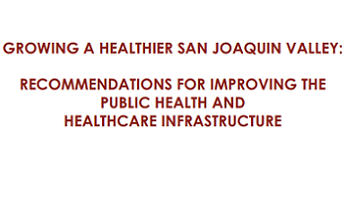
The California Partnership for the San Joaquin Valley includes state agency secretaries and appointed Central Valley represenatitives to provide recommendations for Govenor Schwarzenegger for improving economic condintions of the San Joaquin Valley. Issues of concern identified by this group include the categories of: outmoded public health and healthcare financing systems, inadequate healthcare infrastructure, and health professional shortages. The eight San Joaquin Valley health departments and agenices have drafted these recommendations under the broad categories of healthcare and public health financing, health professional shortages, and healthcare and public health infrastructure.

In an effort to respond to regional concerns regarding health professional shortages
in California’s San Joaquin Valley and
the effect of these shortages on the health of Valley residents, the Central Valley
Health Policy Institute at California State University, Fresno conducted a survey
to evaluate the effects of these shortages on Valley residents. The survey had three
primary objectives:
- Describe the impact that health professional shortages have on access to primary health care in the eight counties of the San Joaquin Valley (Fresno, Kern, Kings, Madera, Merced, San Joaquin, Stanislaus, Tulare)
- Describe current patterns of federal, and other resources, coming to community, private, and rural health clinics in the San Joaquin Valley
- Identify new approaches to addressing the consequences of health professional shortages
This report provides preliminary fi ndings from responses to the survey completed
by eight federally qualified health clinics
(FQHCs).

Medi-Cal Redesign: Implications for the San Joaquin Valley
June 2005
With the goal of providing support to individuals and groups in the region as they
enter this complex policy and program debate, the Central Valley Health Policy Institute
held a policy briefing and community forum, Medi-Cal Redesign: What Does It Mean for
the Valley?, on April 25, 2005 in
Fresno. The forum was attended by approximately 100 people from throughout the region
and featured a presentation by a representative from the California Department of
Health Services (DHS), commentaries by state and local healthcare leaders, and extensive
participation by attendees. We also reviewed published and web-based resources on
Medicaid redesign initiatives in California and nationally, and sought input from
diverse policy-makers, advocates, and academics with relevant expertise. In this brief
we summarize the Administration’s proposals and highlight perspectives and recommendations
from the community forum and our review.
Download the Policy Brief (PDF)
Download the Policy Brief Summary (PDF)

Healthy People 2010: A 2005 Profile of Health Status in the San Joaquin Valley
2005
In 2003, researchers at the Central California Center for Health and Human Services
at California State University, Fresno began exploring the health status of the residents
of the eight San Joaquin Valley counties of Fresno, Kern, Kings, Madera, Merced, San
Joaquin, Stanislaus, and Tulare using the 10 leading health indicators found in Healthy
People 2010. In 2003 they produced Healthy People 2010: A 2003 Profile of Health Status
in the Central San Joaquin Valley (2003 Profi le; Perez & Curtis, 2003). The 2003
Profile provided baseline data on the health status of residents in
the Valley and identified areas where improvement was needed.
This report, Healthy People 2010: A 2005 Profile of Health Statusin the San Joaquin Valley (2005 Profi le), is intended to providean update on the health status of the residents of those same San Joaquin Valley counties, again using the 10 leading health indicators set forth in Healthy People 2010 and the baseline data from the 2003 Profile.

Expanding Employment-Based Health Insurance in the San Joaquin Valley
August 2004
Lack of health insurance coverage interferes with an individual’s ability to access
primary and preventive health care and is associated with worse overall health for
many San Joaquin Valley employees and their families. The Health Insurance Act of
2003, or Senate Bill 2 (SB 2), addresses the needs of these uninsured workers and
their dependents. The bill was passed by the legislature and signed by Governor Davis
in 2003. However, a coalition of business groups sponsored a referendum, Proposition
72, which will be on the November 2004 ballot, seeking to repeal the law prior to
its implementation. This report gathered data about the uninsured of employees in
the San Joaquin Valley.

Healthy People 2010: A 2003 Profile of Health Status in the Central San Joaquin Valley
January 2003
The purpose of this report is to explore the health status of the residents of the Central San Joaquin Valley counties of Fresno, Kern, Kings, Madera, Merced, San Joaquin, Stanislaus, and Tulare using the 10 Leading Health Indicators found in Healthy People 2010. This report utilizes tables, graphics, and GIS mapping to show and document key health issues. This data will provide a baseline for the current status of populations in the Central San Joaquin Valley counties and identify areas in need of improvement. It is expected that this report will be updated periodically until the year 2010.
Children's Institute Publications


